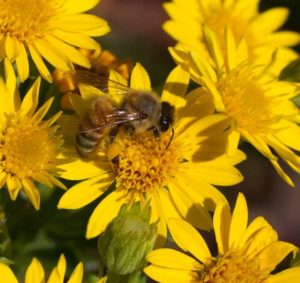Are honey bees native?

Photo courtesy of Debbie Roos
Honey bees were introduced to North America by European settlers in the 1600s. The honey bee (Apis mellifera) is native to Europe and parts of Asia and Africa. While bumble bees can store small amounts of honey, there are no native honey bees in North America. Go to the North Carolina State Beekeepers Association to find out more about honey bees.
How can I get rid of carpenter bees?
Before waging war on carpenter bees, remember they are good pollinators! Recommendations for carpenter bee control, along with more information on carpenter bee biology, can be found in this NCSU Insect Note.
Check out this cool diagram of a carpenter bee’s lifecycle:

How many native bee species can be found in North Carolina?
North Carolina is home to more than 500 species of native bees. Many are economically vital to our agricultural industry. In addition to bees, there are approximately 177 species of butterflies, over 2,800 species of moths and an unknown number of other insect pollinators in North Carolina.
Click here to find out more about our native pollinators, and check out this article from the ‘Wildlife in North Carolina’ magazine (March/April 2020) that talks about North Carolina native bees:

Photo courtesy of Melissa McGaw
Do all bees die after they sting?
No, only honey bees suffer this fate. Honey bees have barbed stingers that embed in your skin. When the bee flies away, the stinger is torn from her body, and she dies. If you are stung by a honey bee, remove the stinger immediately to reduce sting severity.
